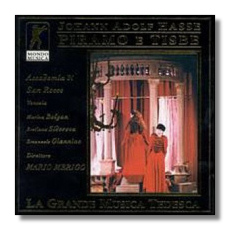
The Internet's Premier Classical Music Source
Related Links
- Latest Reviews
- More Reviews
-
By Composer
-
Collections
DVD & Blu-ray
Books
Concert Reviews
Articles/Interviews
Software
Audio
Search Amazon
Recommended Links
Site News
 CD Review
CD Review
Johann Adolph Hasse

Piramo e Tisbe
Marina Bolgan, soprano
Svetlana Svorodova, mezzo-soprano
Emanuele Giannino, baritone
Academia di San Rocco, Venice/Mario Merigo
Mondo Musica 10100 2CDs 97:50
Few composers were as famous in their time as Johann Adolf Hasse (1699-1783), only to disappear so quickly from public view after their death. For decades during the 18th century his Italian opera seria were far and away the most popular of all in Italy and Germany, and he was highly regarded and richly rewarded during his years in Naples, Venice, and Dresden. He had a good sense of stagecraft and was a master at writing long, flowing, vocal lines that allowed his singers to illuminate the words of his texts.
Most of his operas were setting of Metastasio texts, but the libretto for Piramo e Tisbe, written in 1768, was by Marco Cotellini. It draws on the story from Ovid's Metamorphoses that Shakespeare burlesqued in A Midsummer Night's Dream, and is quite simple: the love of Pyramus and Thisbe is thwarted by the enmity of their families, and when Thisbe is told she must marry someone else, they decide to run away. Thisbe is startled by an animal near their meeting place, drops her jewel box and veil, and when Pyramus finds them, he thinks she is dead and stabs himself in despair. Thisbe returns, finds him dying, and thereupon stabs herself, and when her father discovers the bodies, he remorsefully kills himself as well.
In spite of this dreary tale, the music sparkles with life. By the time the opera was written, Hasse had abandoned the da capo aria in favor of freer and more irregular forms for the orchestra as well as the arias, and one lovely tune follows another. Unfortunately, this is not a very good production. It was recorded in poor sound at a live performance in 1997; the singers and orchestra are no more than competent and Mario Merigo's leadership is uninspired. The notes are skimpy, providing no information about the performers and no text. There is a Koch Schwann recording (310882) of this lovely music, led by Helmut Müller-Brühl; it isn't great, but it is considerably better than this one.
Copyright © 1999, Alexander J. Morin


















